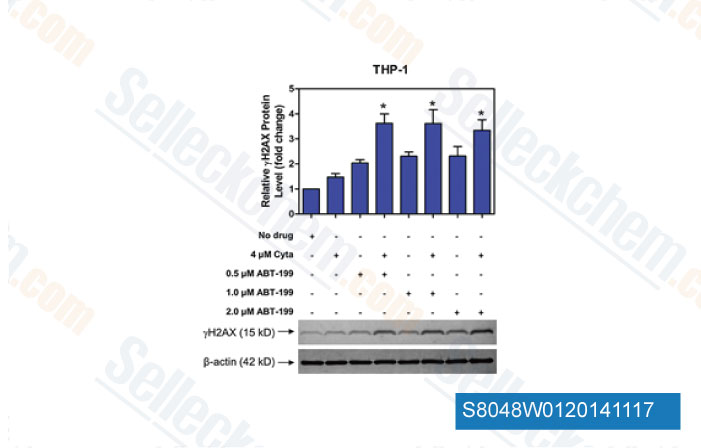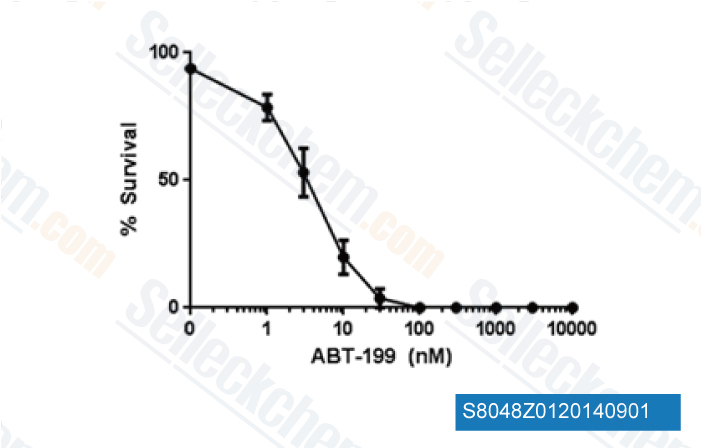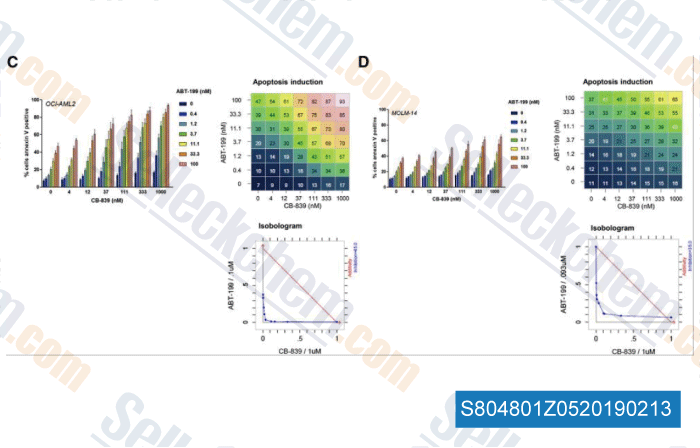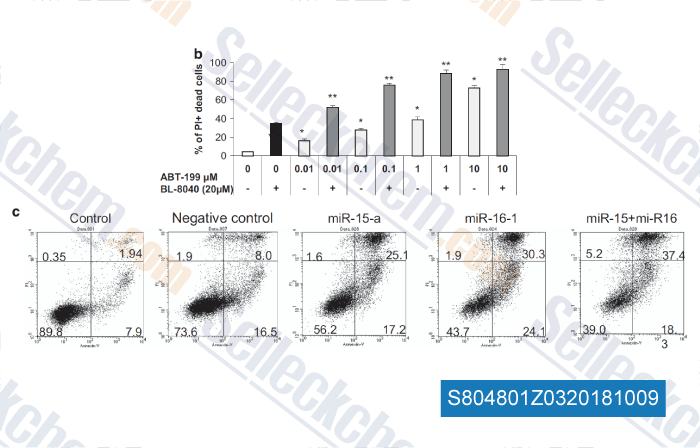|
Toll Free: (877) 796-6397 -- USA and Canada only -- |
Fax: +1-832-582-8590 Orders: +1-832-582-8158 |
Tech Support: +1-832-582-8158 Ext:3 Please provide your Order Number in the email. |
Technical Data
| Formula | C45H50ClN7O7S |
|||
| Molecular Weight | 868.44 | CAS No. | 1257044-40-8 | |
| Solubility (25°C)* | In vitro | DMSO | 100 mg/mL (115.14 mM) | |
| Water | Insoluble | |||
| Ethanol | Insoluble | |||
|
* <1 mg/ml means slightly soluble or insoluble. * Please note that Selleck tests the solubility of all compounds in-house, and the actual solubility may differ slightly from published values. This is normal and is due to slight batch-to-batch variations. * Room temperature shipping (Stability testing shows this product can be shipped without any cooling measures.) |
||||
Preparing Stock Solutions
Biological Activity
| Description | Venetoclax (ABT-199, GDC-0199) is a Bcl-2-selective inhibitor with Ki of <0.01 nM in cell-free assays, >4800-fold more selective versus Bcl-xL and Bcl-w, and no activity to Mcl-1. Venetoclax is reported to induce cell growth suppression, apoptosis, cell cycle arrest, and autophagy in triple negative breast cancer MDA-MB-231 cells. Phase 3. | ||
|---|---|---|---|
| Targets |
|
||
| In vitro | ABT-199 shows less sensitivity to Bcl-xL, Mcl-1 and Bcl-w with Ki of 48 nM, > 444 nM and 245 nM, respectively. ABT-199 potently inhibits FL5.12-Bcl-2 cells, RS4;11 cells with EC50 of 4 nM and 8 nM, while shows low activity against FL5.12-Bcl-xL cells with EC50 of 261 nM. ABT-199 induces a rapid apoptosis in RS4;11 cells with cytochrome c release, caspase activation, the externalization of phosphatidylserine and the accumulation of sub-G0/G1 DNA. Quantitative immunoblotting reveals that sensitivity to ABT-199 correlated strongly with the expression of Bcl-2, including NHL, DLBCL, MCL, AML and ALL cell lines. ABT-199 also induces apoptosis in CLL with an average EC50 of 3.0 nM. [1] | ||
| In vivo | ABT-199 (100 mg/kg) causes a maximal tumor growth inhibition of 95% and tumor growth delay of 152% in RS4;11 xenografts. ABT-199 also inhibits xenograft growth (DoHH2, Granta-519) as a single agent or in combination with SDX-105 and other agents. [1] | ||
| Features | Re-engineered version of ABT-263 (Navitoclax). |
Protocol (from reference)
| Kinase Assay:[1] |
|
|---|---|
| Cell Assay:[1] |
|
| Animal Study:[1] |
|
Customer Product Validation

-
Data from [Data independently produced by Mol Oncol, 2014, 10.1016/j.molonc.2014.09.008]

-
Data from [J Biol Chem, 2014, 289(23), 16190-9]

-
Data from [Data independently produced by , , Blood, 2015, 126(11):1346-56]

-
Data from [Data independently produced by , , Leukemia, 2017, 31(11):2336-2346]
Selleck's Venetoclax (ABT-199) has been cited by 601 publications
| Comprehensive characterization of IFNγ signaling in acute myeloid leukemia reveals prognostic and therapeutic strategies [ Nat Commun, 2024, 15(1):1821] | PubMed: 38418901 |
| BH3 mimetics and azacitidine show synergistic effects on juvenile myelomonocytic leukemia [ Leukemia, 2024, 38(1):136-148] | PubMed: 37945692 |
| Induction of IFIT1/IFIT3 and inhibition of Bcl-2 orchestrate the treatment of myeloma and leukemia via pyroptosis [ Cancer Lett, 2024, 588:216797] | PubMed: 38462032 |
| Deoxycytidine kinase inactivation enhances gemcitabine resistance and sensitizes mitochondrial metabolism interference in pancreatic cancer [ Cell Death Dis, 2024, 15(2):131] | PubMed: 38346958 |
| Inhibition of NRF2 enhances the acute myeloid leukemia cell death induced by venetoclax via the ferroptosis pathway [ Cell Death Discov, 2024, 10(1):35] | PubMed: 38238299 |
| Panobinostat sensitizes AraC-resistant AML cells to the combination of azacitidine and venetoclax [ Biochem Pharmacol, 2024, S0006-2952(24)00048-0] | PubMed: 38373594 |
| CAD204520 Targets NOTCH1 PEST Domain Mutations in Lymphoproliferative Disorders [ Int J Mol Sci, 2024, 25(2)766] | PubMed: 38255842 |
| Licochalcone A induces mitochondria-dependent apoptosis and interacts with venetoclax in acute myeloid leukemia [ Eur J Pharmacol, 2024, 968:176418] | PubMed: 38350590 |
| Venetoclax efficacy on acute myeloid leukemia is enhanced by the combination with butyrate [ Sci Rep, 2024, 14(1):4975] | PubMed: 38424468 |
| Genome-wide CRISPR screen reveals the synthetic lethality between BCL2L1 inhibition and radiotherapy [ Life Sci Alliance, 2024, 7(4)e202302353] | PubMed: 38316463 |
RETURN POLICY
Selleck Chemical’s Unconditional Return Policy ensures a smooth online shopping experience for our customers. If you are in any way unsatisfied with your purchase, you may return any item(s) within 7 days of receiving it. In the event of product quality issues, either protocol related or product related problems, you may return any item(s) within 365 days from the original purchase date. Please follow the instructions below when returning products.
SHIPPING AND STORAGE
Selleck products are transported at room temperature. If you receive the product at room temperature, please rest assured, the Selleck Quality Inspection Department has conducted experiments to verify that the normal temperature placement of one month will not affect the biological activity of powder products. After collecting, please store the product according to the requirements described in the datasheet. Most Selleck products are stable under the recommended conditions.
NOT FOR HUMAN, VETERINARY DIAGNOSTIC OR THERAPEUTIC USE.
